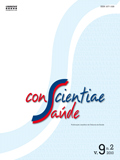Postural assessment by photogrammetry in individuals who have Legg-Calvé Perthes disease
DOI:
https://doi.org/10.5585/conssaude.v9i2.2156Keywords:
Legg Calve Perthes, Photogrammetry, Postural assessment.Abstract
Introduction: The Legg-Calve-Perthes disease has been studied since 1910, however we still do not know much about it because there is a lack of patient follow-up to the end of the residual phase, in which the individual can show geometric changes in the femoral head, which may lead to postural changes. Objective: Evaluate the attitude of the individuals who had Legg-Calve-Perthes disease by photogrammetry and correlate possible changes with the disease. Methods: Seven patients who had Legg-Calve-Perthes disease for at least five years were recruited and evaluated by means of photogrammetry. The angles and the values achieved were made through the program, Corel Draw®. Results: In the front view: knee valgus in 43% of the posterior view: the EIPS opposite the affected side higher (41%), in lateral view: an increase of lumbar lordosis, thoracic kyphosis and cervical lordosis. Conclusion: We observed changes in knee joints, pelvic girdle and spinal curvatures, with a prevalence in individuals affected by the disease on the left.Downloads
Downloads
Published
How to Cite
Issue
Section
License
Copyright (c) 2010 ConScientiae Saúde

This work is licensed under a Creative Commons Attribution-NonCommercial-ShareAlike 4.0 International License.
Autores que publicam nesta revista concordam com os seguintes termos:
O(s) autor(es) autoriza(m) a publicação do texto na revista;
O(s) autor(es) garantem que a contribuição é original e inédita e que não está em processo de avaliação em outra(s) revista(s);
A revista não se responsabiliza pelas opiniões, idéias e conceitos emitidos nos textos, por serem de inteira responsabilidade de seu(s) autor(es);
É reservado aos editores o direito de proceder a ajustes textuais e de adequação às normas da publicação;
Autores mantém os direitos autorais e concedem à revista o direito de primeira publicação, com o trabalho simultaneamente licenciado sob uma Licença Creative Commons Atribuição-NãoComercial-CompartilhaIgual 4.0 Internacional;
Autores têm permissão e são estimulados a publicar e distribuir seu trabalho online (ex.: em repositórios institucionais ou na sua página pessoal) já que isso pode gerar alterações produtivas, bem como aumentar o impacto e a citação do trabalho publicado;
Em virtude de aparecerem nesta revista de acesso público, os artigos são de uso gratuito, com atribuições próprias, em aplicações educacionais e não-comerciais.



